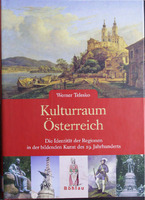Kulturraum Österreich
Die Identität der Regionen in der bildenden Kunst des 19. Jahrhunderts
Author(s)
Telesko, Werner
Collection
Austrian Science Fund (FWF)Language
GermanAbstract
While the first volume of the overalll work, which was published as "The historical Area of Austria" ("Geschichtsraum Österreich") in 2006, focused on the Hapsburgian "whole state" from the perspective of the most important phenomena and protagonists of the "Hapsburgian iconography", this second and concluding volume examines multifarious visualisations of the regional and supraregional historical myths of the 19th century in Vienna, the "centre", and in the regions, i.e. the Austrian Crownlands (part of which are identical with today´s federal provinces of the Republic of Austria). The difficult relationship between the "whole state" and the Crownlands constitutes the entire, extremely complex spectrum of reflections on Austrian 19th century history. Here, the kinds of methods and concrete goals with which regional memorial foundations interact or compete with dynastic strategies is a pivotal issue - on that has been examined only far too rarely in the past. Hence the present work intends to discuss both art-historical and historical phenomena with explore various historical reflections at the - frequently neglected - "periphery" and investigate visual approaches to one´s "own" history from the "present" of the 19th century (using prominent events such as the second Ottoman siege of 1683 and the "wars of liberation" against Napoleon as an example). The degrees of complexity, quantitative permeation and significant contrasts between Vienna - the "centre" - and the "provinces" in their different reflections on Austrian history clearly begin to emerge when we examine an extensive range of topics against the background of competing national, regional and communal strategies. Compared to the first volume "The historical Area of Austria", the perspective of the multifarious "historical area of Austria" shifts from the "whole state" to an analysis of a highly distinct "plurality of areas" (Karl Schlögel) with its own intrinsic laws. Such diversity is also an essential factor when we come to investigate the prolific amount of Austrian landscape art in the 19th century and the role it played in forging identity. It graphically demonstrates that a deeper understanding of Austria´s federal structures is not possible without gaining a comprehensive insight into 19th century history. Während im ersten Band der Gesamtpublikation, der unter dem Titel "Geschichtsraum Österreich" im Jahr 2006 erschienen ist, der habsburgische "Gesamtstaat" aus dem Blickpunkt der wichtigsten Phänomene und Protagonisten der "habsburgischen Ikonographie" im Zentrum des Interesses stand, werden im vorliegenden zweiten und abschließenden Band die vielfältigen Visualisierungen der regionalen und überregionalen historischen Mythen im 19. Jahrhundert im Zentrum Wien und in den Regionen, den österreichischen Kronländern (zum Teil mit den heutigen Bundesländern der Republik Österreich), untersucht. Das schwierige Verhältnis zwischen dem "Gesamtstaat" und den Ländern konstituiert das gesamte und höchst vielschichtige Spektrum der österreichischen Geschichtsreflexionen im 19. Jahrhundert. Wie und mit welchen konkreten Zielsetzungen regionale Gedächtnisstiftungen mit dynastischen Strategien zusammenwirken oder diese konkurrenzieren, ist eine wesentliche und bisher viel zu selten untersuchte Fragestellung. In der vorliegenden Arbeit sollen somit sowohl kunstgeschichtliche als auch historische Phänomene zur Sprache kommen, die einerseits die vielfältigen Geschichtsreflexionen an der - häufig vernachlässigten - "Peripherie" in den Blickpunkt nehmen, und andererseits den visuellen Umgang mit der "eigenen" Geschichte (etwa anhand der prominenten Ereignisse der zweiten Türkenbelagerung 1683 und der "Befreiungskriege" gegen Napoleon) aus der "Gegenwart" des 19. Jahrhunderts beleuchten. Anhand unterschiedlichster Themenkreise kann deutlich gemacht werden, in welcher komplexen Weise, mit welchem Grad der quantitativen Durchdringung und mit welchen signifikanten Gegensätzen zwischen dem "Zentrum" Wien und der "Provinzen" die österreichische Geschichte im Spannungsfeld von nationalen, regionalen und kommunalen Strategien reflektiert wurde. Die Perspektive auf den vielfältigen "Geschichtsraum Österreich" verlagert sich - im Vergleich zum ersten Band - vom "Gesamtstaat" zur Analyse der höchst unterschiedlichen und eigengesetzlichen "Pluralität der Räume" (Karl Schlögel). Diese Vielfalt ist auch für die Untersuchung der reichen Produktion der österreichischen Landschaftskunst im 19. Jahrhundert hinsichtlich ihrer identitätsstiftenden Gehalte wesentlich und zeigt in anschaulicher Weise, daß ein tiefes Verständnis der föderalen Strukturen Österreichs nicht ohne einen umfassenden Blick des 19. Jahrhunderts möglich ist.
Keywords
Art History; Austrian History; Monuments; European History of the 19th Century; History Painting; The Austrian Crownlands; Österreich; WienDOI
10.26530/oapen_437146ISBN
9783205777205OCN
995254199Publisher
BrillPublisher website
https://brill.com/Publication date and place
2008Grantor
Imprint
BöhlauClassification
The Arts


 Download
Download